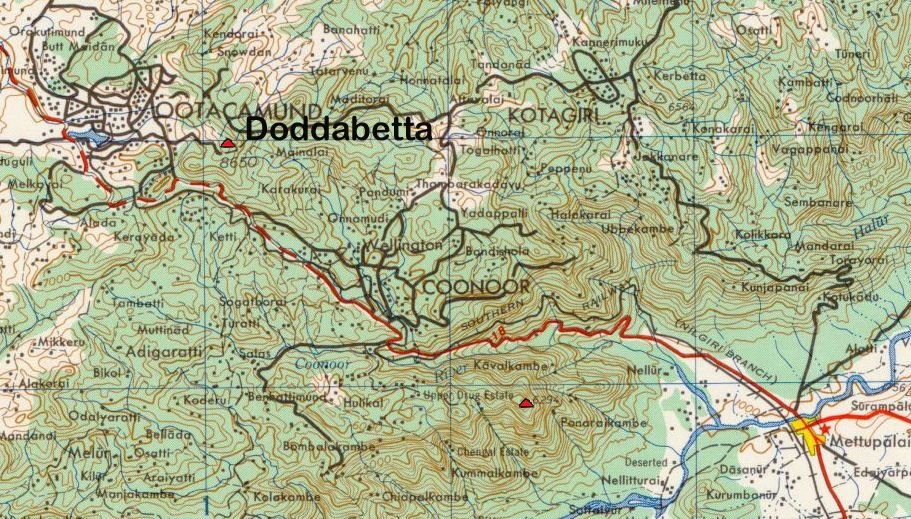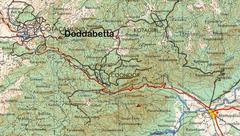
Nilgiri Mountain Railway Visiting Guide: Tickets, Hours, and Tips
Date: 14/06/2025
Introduction
Nestled in the lush Nilgiri Hills of Tamil Nadu, the Nilgiri Mountain Railway (NMR) is a UNESCO World Heritage Site renowned for its remarkable engineering and breathtaking scenic journey. Popularly known as the “Ooty Toy Train,” the NMR connects Mettupalayam in the plains to the hill station of Ooty (Udhagamandalam), traversing steep gradients, verdant tea estates, and charming colonial-era stations. This comprehensive guide provides essential information on visiting hours, ticket booking, travel tips, and highlights of the NMR route, ensuring a memorable adventure for every traveler (Ooty Tourism, Wikipedia).
Historical Background and Engineering Significance
Colonial Origins and Strategic Importance
The Nilgiri Mountain Railway was conceived during the British colonial era to provide access to the cool, picturesque Nilgiri Hills, then the summer capital of the Madras Presidency. Construction began in 1891 under Swiss engineer Niklaus Riggenbach, renowned for his rack railway expertise. The railway reached Coonoor in 1899, Fernhill in 1907, and Ooty in 1908, culminating in a 46-kilometer route that swiftly became vital for passenger and goods transport, especially for tea and produce.
Socio-Economic and Cultural Impact
Beyond transportation, the NMR spurred the region’s economic growth, fostering tea plantations and the expansion of hill stations like Coonoor and Wellington. In 2005, its unique engineering and cultural legacy were recognized as part of the UNESCO “Mountain Railways of India” World Heritage Site, alongside Darjeeling and Kalka-Shimla railways.
Engineering Marvels
The NMR climbs over 1,877 meters using the Abt rack and pinion system, allowing it to conquer gradients as steep as 1 in 12.5 (8.33%). The route boasts 16 tunnels, 250 bridges, and 208 sharp curves, making it Asia’s steepest and only rack railway (Wikipedia).
Route Overview and Key Stations
The railway covers 46 km from Mettupalayam (326 m elevation) to Ooty (2,203 m elevation), offering a journey through forests, tea estates, and misty valleys. Key stations include:
- Mettupalayam: The departure point, accessible from Coimbatore.
- Kallar: Where the ascent into the Nilgiris begins.
- Hillgrove: Noted for engine maintenance stops and scenic surroundings.
- Coonoor: Major hill town, often where steam engines transition to diesel.
- Wellington: Near the cantonment area with beautiful vistas.
- Lovedale: A serene, high-altitude stop.
- Ooty (Udhagamandalam): The terminus and Queen of the Nilgiris (Oyo Rooms, Tusktravel).
The route’s 16 tunnels, 250 bridges, and 208 curves deliver unparalleled views of the Nilgiris (EIndiaTourism).
Visiting Hours and Journey Timings
- Mettupalayam–Ooty Uphill: Departs 7:10 am, arrives around noon (4.8–5 hours).
- Ooty–Mettupalayam Downhill: Departs 2:00 pm, arrives 5:35 pm (about 3.5 hours).
- Coonoor–Ooty Shuttle: Several daily round trips for short-distance travelers.
Timings may vary; always check the latest schedule via the IRCTC website or local tourism portals (Wikipedia, EIndiaTourism).
Tickets and Booking
Booking Methods
- Online: Book via the IRCTC website for guaranteed seats. Booking opens two months in advance; high demand means early reservation is advised (Travel Thrive Hub).
- Offline: Limited tickets at Mettupalayam, Coonoor, and Ooty stations; these sell out quickly, especially for the full route (Bon Sejour Ooty).
Classes and Fares
- First Class: Cushioned seats, large windows; fares around ₹600.
- Second Class: Basic comfort; fares about ₹295.
- Unreserved: Cheapest, but can be crowded; fares about ₹175 (Railway Traveller).
Booking Tips
- Book early, especially October–June.
- Carry a printed ticket for smooth boarding.
- Arrive at least 30 minutes before departure.
Onboard Experience
Carriage Types
- First Class: Spacious, ideal for panoramic views.
- General/Second Class: More budget-friendly, can get crowded in peak season.
Locomotives
- Steam Engines: Operate Mettupalayam–Coonoor; a highlight for train enthusiasts.
- Diesel Engines: Run Coonoor–Ooty; restoration of full steam services is ongoing (Wikipedia).
Sensory Highlights
- The rhythmic chug of steam engines, the scent of eucalyptus and tea, and stunning views make this journey truly immersive (Fernwehrahee).
Facilities
- Food: Limited onboard; buy snacks at stations.
- Restrooms: Available at major stations but not onboard.
- Luggage: Carry light; storage is limited.
Best Time to Visit and Weather Considerations
- October to June: Best season for clear skies and pleasant weather.
- Monsoon (July–September): Lush scenery but frequent delays or landslides.
- Winter (November–February): Crisp air, cold at higher altitudes.
Tips: Dress in layers, carry rain gear during monsoon, and use sun protection even on cool days (Oyo Rooms, Thrillophilia).
Accessibility and Getting There
- To Mettupalayam: Well connected by road/train from Coimbatore (40 km).
- To Ooty Station: Central in Ooty, accessible by taxi, rickshaw, or local bus (Thrillophilia).
- Local Transport: Auto-rickshaws, cabs, and buses available for station transfers.
Accessibility: Main stations have basic facilities for travelers with mobility challenges, but older stations and coaches may have limited access. Contact railway staff ahead for assistance.
Notable Sights and Historical Sites Near the Railway
- Ooty Botanical Gardens: Renowned for rare flora and ancient trees.
- Ooty Lake: Popular for boating and picnics.
- Doddabetta Peak: Highest point in the Nilgiris.
- St. Stephen’s Church: Historic 19th-century church.
- Government Rose Garden: Home to thousands of rose varieties.
These attractions are easily accessible from Ooty station and enhance the overall Nilgiri experience.
Special Events and Photography
- Photographic Hotspots: Lovedale Station, Kallar Bridge Viaduct, Wellington viewpoints, and the dramatic tunnels.
- Events: Heritage festivals and steam engine showcases occur seasonally. Check local tourism websites for updates.
Practical Travel Tips
- Book tickets early, especially during peak season.
- Plan for weather changes: Bring warm clothing and rain gear.
- Arrive early at departure stations.
- Supervise children and elderly travelers due to open windows and sharp curves.
- Dispose of waste responsibly and respect the local environment.
- Support local businesses and participate in conservation efforts to preserve the Nilgiri ecosystem (IOSR Journals).
Frequently Asked Questions
Q: How do I book Nilgiri Mountain Railway tickets?
A: Book online via the IRCTC website or at station counters. Advance booking is essential, especially for First Class and full-route tickets.
Q: What are the Nilgiri Mountain Railway visiting hours?
A: Trains run daily from about 7:00 am to 5:00 pm, but schedules can vary. Always verify timings before travel.
Q: Is the NMR accessible for differently-abled travelers?
A: Main stations have basic accessibility, but some older stations and coaches may be challenging. Contact staff in advance for assistance.
Q: When is the best time to travel?
A: October to June offers the best weather and scenery. Monsoon brings lush greenery but also the risk of delays.
Q: Are steam engines still used?
A: Yes, steam locomotives operate between Mettupalayam and Coonoor; diesel engines run from Coonoor to Ooty (Railway Traveller).
Cultural, Economic, and Environmental Impact
The NMR is more than a tourist draw—it is a lifeline for local communities and a symbol of pride in the Nilgiris. The railway sustains local businesses and hospitality sectors, but increased tourism also puts pressure on the environment. Visitors are encouraged to travel responsibly, respect heritage structures, and support sustainable tourism initiatives (IOSR Journals, Times of India).
Conclusion
The Nilgiri Mountain Railway is not merely a mode of transportation—it is a living heritage, an engineering marvel, and a gateway to the enchanting Nilgiri Hills. Whether you are a history enthusiast, a nature lover, or a curious traveler, a ride on the NMR promises unforgettable vistas and rich cultural experiences. Book your journey in advance, plan your visit with this detailed guide, and immerse yourself in the charm of Ooty and the Nilgiris.
For ongoing updates, exclusive offers, and in-depth travel guides, download the Audiala app and follow our channels.
Sources and Further Reading
- Ooty Tourism: Nilgiri Mountain Railway
- Oyo Rooms: Nilgiri Mountain Railway Travel Guide
- IRCTC Official Website
- TravelEscape: Nilgiri Mountain Railway Toy Train
- Wikipedia: Nilgiri Mountain Railway
- Tusktravel: Nilgiri Mountain Railway Travel Guide
- EIndiaTourism: Ooty Toy Train
- Bon Sejour Ooty: Nilgiri Mountain Railway
- Railway Traveller: Nilgiri Mountain Railway
- Thrillophilia: Nilgiri Mountain Railway
- Fernwehrahee: Ooty Mountain Train
- Times of India: Nilgiri Mountain Railway
- IOSR Journals: Economic and Environmental Impact

